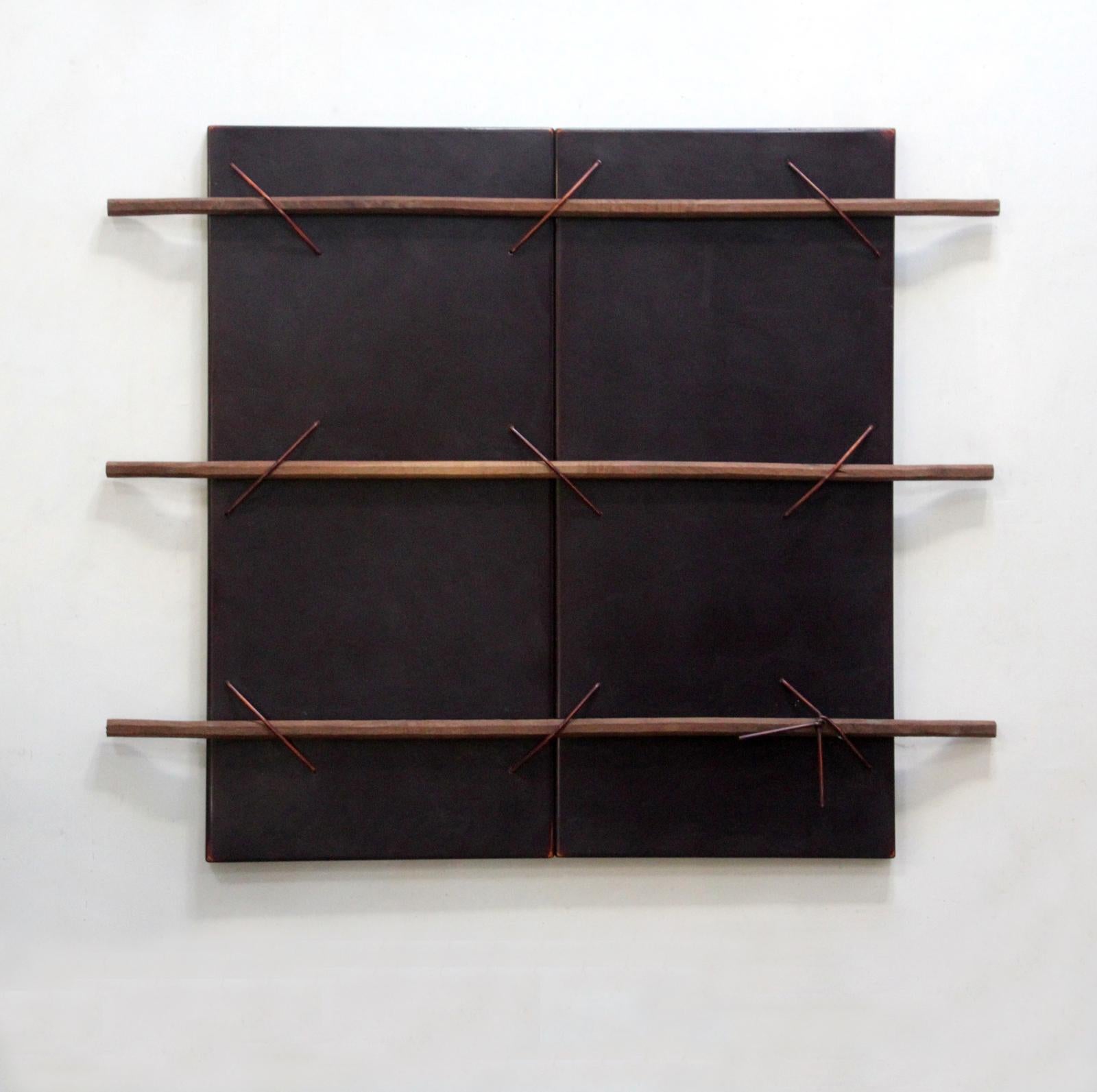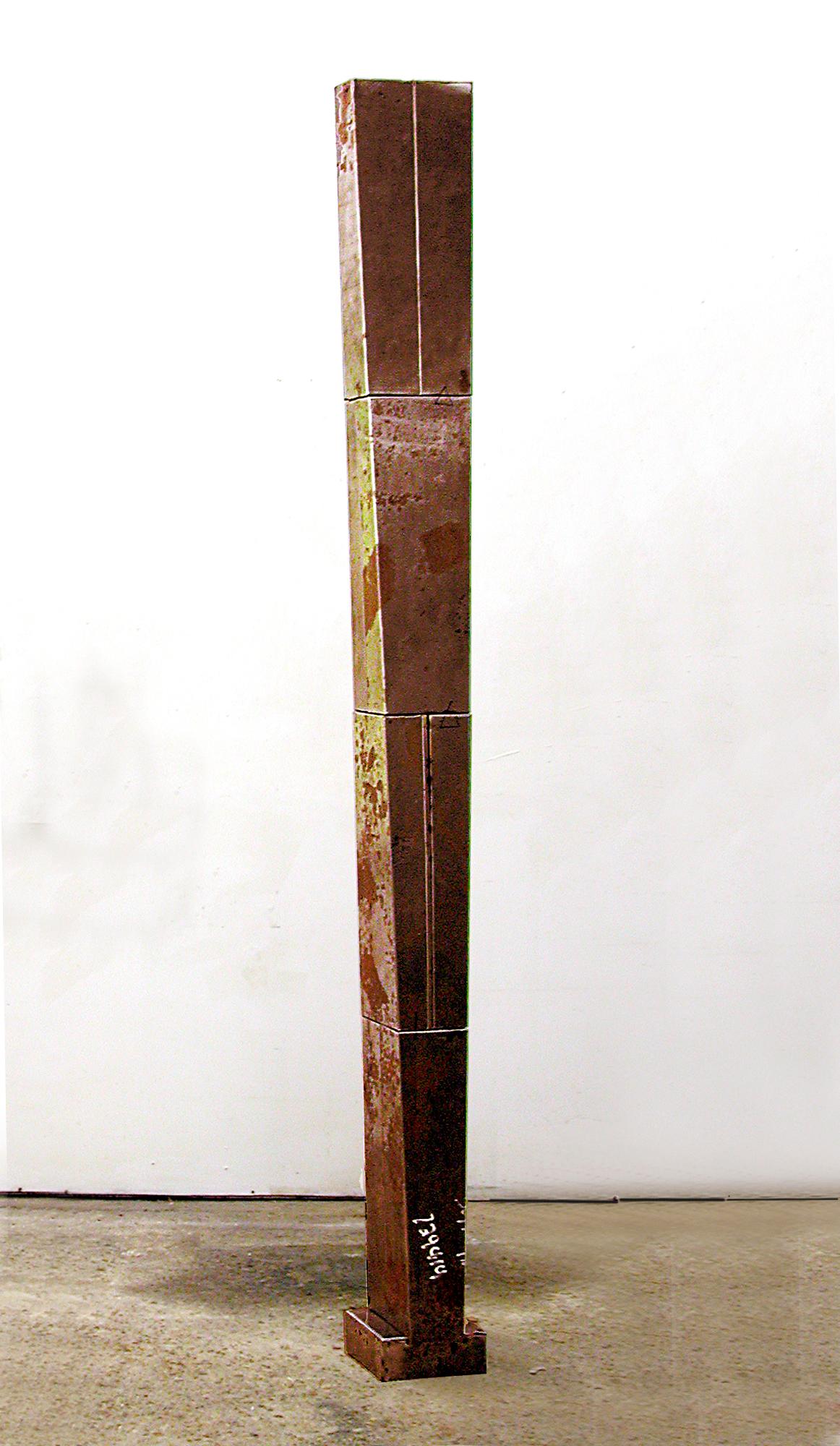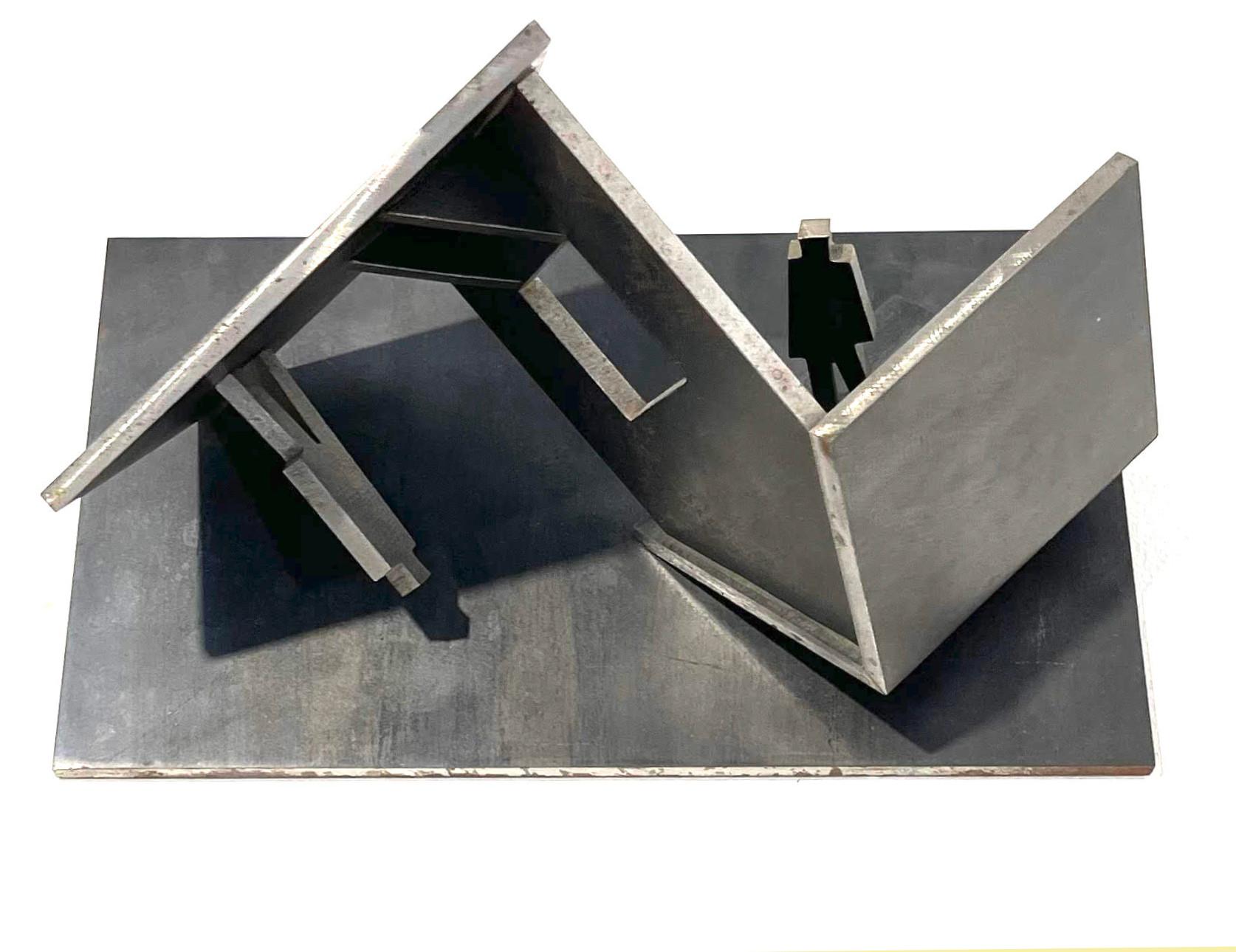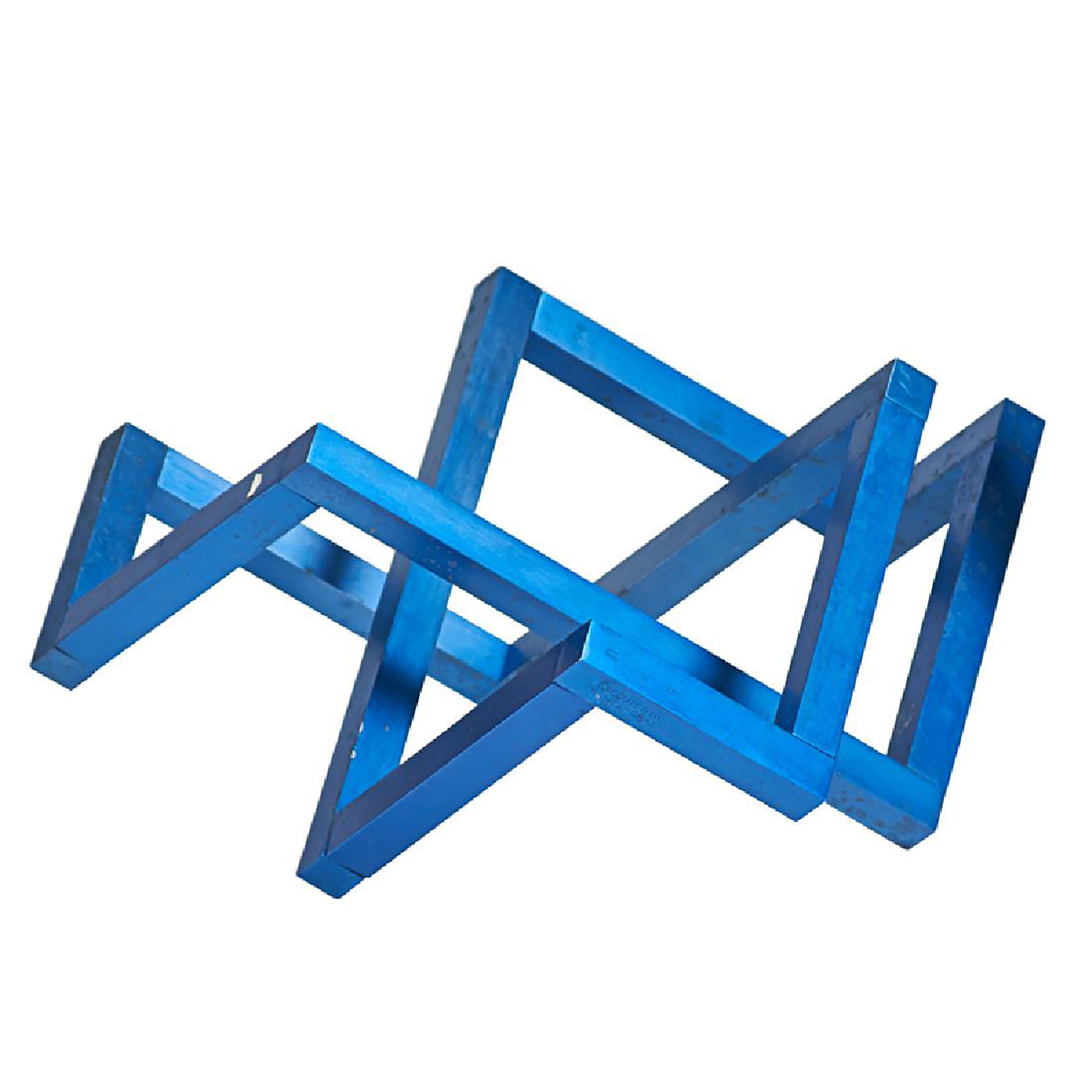Items Similar to "Untitled" Sidney Gordin, Constructivist Abstract Sculpture, Bronze Metal Weld
Want more images or videos?
Request additional images or videos from the seller
1 of 5
Sidney Gordin"Untitled" Sidney Gordin, Constructivist Abstract Sculpture, Bronze Metal Weld1958
1958
About the Item
Sidney Gordin
Untitled, 1958
Signed with initials and dated
Bronze
15 1/2" high x 5 1/2" wide x 5" deep
Provenance:
Private Collection, Phoenix, Arizona
Tim Mitchell, Phoenix, Arizona (acquired directly from the above)
On October 24, 1918, Sidney Gordin was born in Chelyabinsk, Russia. He spent his early years in Shanghai, China. At the age of four, he moved with his family to New York. Gordin’s nephew, Eliot Nemzer recalls that when Gordin was a child he attended “a dinner party with his parents. Someone showed him a book of pictures that when thumbed through quickly made the image appear to move. This person then gave him a wad of blank papers and something to write with. Sid created a similar type of moving image with his materials. All the adults at the party became quite excited [and] praised his efforts. Sid told me he thought this was a pivotal experience in guiding him towards his vocation.” During his formative years at Brooklyn Technical High School, he briefly contemplated the idea of becoming an architect; yet, by the time he enrolled at Cooper Union, he was determined to become a professional artist. There, he studied under Morris Kantor (1896-1974) and Leo Katz (1887-1982), devoting much of his class schedule to drawing and painting.
In 1949, Gordin turned his attention to sculpture for the first time. Three years later, he held his first solo-exhibition at Bennington College in Vermont and the Peter Cooper Gallery in New York. That same year he was accepted into the Metropolitan Museum of Art’s group exhibition American Sculpture 1951. His metal and wire constructions were shown alongside such sculptors as Alexander Calder (1898-1976), William Zorach (1887-1966), and George Rickey (1907-2002). Over the following years, he regularly exhibited in the annual exhibitions of the Whitney Museum of American Art, while also holding yearly solo-exhibitions at the Grace Borgenicht Gallery in New York. Three days into his first solo-exhibition at Borgenicht in 1953, the Whitney made their first acquisition of his work by purchasing a metal construction for their permanent collection.
By the late 1950s, he began to employ wood in his sculptures, which eventually led to the creation of painted constructions. With a renewed interest in painting, Gordin often alternated between these painted wood constructions and two-dimensional painting up until his death in the early 90s.
Following teaching stints at both Sarah Lawrence College and the New School for Social Research in New York, Gordin accepted a position at UC Berkeley’s Department of Art in 1958. Amidst the emerging Bay Area art scene, Gordin taught alongside such artists as Peter Voulkos, Joan Brown, and Jay de Feo. Coinciding with his move to Berkeley, he held his first solo-exhibition on the West Coast at San Francisco’s seminal Dilexi Gallery. In 1962, the M.H. De Young Memorial Museum in San Francisco mounted his first one-man museum show.
Yet, while maintaining his professorship at Berkeley, Gordin never completely cut his ties to the East Coast. He maintained a studio in Provincetown, Massachusetts, which he often visited throughout the years, and continued to appear in several exhibitions organized by the Metropolitan Museum of Art, the Whitney, and the Zabriskie Gallery well into the 90s. Over the next several decades, he was included in prominent group exhibitions such as the Whitney’s Precisionist View in American Art and Geometric Abstraction in America; the exhibition West Coast Now, which traveled from the Portland Art Museum to the Seattle Art Museum, the De Young, and the Los Angeles Municipal Art Gallery; and the Oakland Museum’s exhibition, Art in the San Francisco Bay Area. During the course of his career, he was also included in shows in Paris, Tel Aviv, and Tokyo.
He retired from teaching in 1986 as Professor Emeritus of Art. Following his retirement, he, along with several members of the Berkeley Art Department, founded the Breakfast Club, an eclectic mix of Bay Area artists and students that met weekly for discussions about art and politics and held regular group exhibitions for many years. Three years before his death in 1993, he was inducted as a Member of the National Academy of Design.
- Creator:Sidney Gordin (1918-1996, American)
- Creation Year:1958
- Dimensions:Height: 15.5 in (39.37 cm)Width: 5.5 in (13.97 cm)Depth: 5 in (12.7 cm)
- Medium:
- Movement & Style:
- Period:
- Condition:
- Gallery Location:New York, NY
- Reference Number:1stDibs: LU1841212464522
About the Seller
5.0
Platinum Seller
These expertly vetted sellers are 1stDibs' most experienced sellers and are rated highest by our customers.
Established in 2021
1stDibs seller since 2022
59 sales on 1stDibs
Typical response time: 1 hour
- ShippingRetrieving quote...Ships From: New York, NY
- Return PolicyA return for this item may be initiated within 3 days of delivery.
More From This SellerView All
- "Untitled" Sidney Gordin, Abstract Metal Steel SculptureBy Sidney GordinLocated in New York, NYSidney Gordin Untitled, 1958 Incised with initials Welded Steel 15 x 10 1/2 x 6 inches Provenance: Eric Firestone Gallery, New York On October 24, 1918, Sidney Gordin was born in Chelyabinsk, Russia. He spent his early years in Shanghai, China. At the age of four, he moved with his family to New York. Gordin’s nephew, Eliot Nemzer recalls that when Gordin was a child he attended “a dinner party with his parents. Someone showed him a book of pictures that when thumbed through quickly made the image appear to move. This person then gave him a wad of blank papers and something to write with. Sid created a similar type of moving image with his materials. All the adults at the party became quite excited [and] praised his efforts. Sid told me he thought this was a pivotal experience in guiding him towards his vocation.” During his formative years at Brooklyn Technical High School, he briefly contemplated the idea of becoming an architect; yet, by the time he enrolled at Cooper Union, he was determined to become a professional artist. There, he studied under Morris Kantor (1896-1974) and Leo Katz...Category
1950s Abstract Abstract Sculptures
MaterialsSteel
- "Roland, " George Sugarman, Abstract Steel SculptureBy George SugarmanLocated in New York, NYGeorge Sugarman (1912 - 1999) Roland, 1970 Patinated steel 17 3/8 x 16 x 5 1/4 inches Incised with the artist's signature and numbered "15/17" on the underside Manufactured by Lippin...Category
1970s Abstract Abstract Sculptures
MaterialsSteel
- "Untitled (Scrap Metal 4415), " Lucien Smith Anti-War SculptureBy Lucien SmithLocated in New York, NYLucien Smith (American, b. 1989) Untitled (Scrap Metal 4415), 2013 Steel 35 x 35 x 15 inches Provenance: OHWOW, Los Angeles Private Collection Wright, 2015, Lot 139 One of the most highly-regarded contemporary artists, Lucien Smith is a name whose work people (and institutions) have been paying much attention to since he graduated Cooper Union. He produced readymade sculptures that the artist has secured and appropriated from the annual Knob Creek Machine Gun Shoot in Kentucky. Consisting of propane tanks, oil drums, automobile parts, and even a full-length truck, the metal objects have all been fired on by thousands of rounds of ammunition from handguns, assault rifles, fully automatic rifles, to a powerful Gatling Gun...Category
2010s Abstract Sculptures
MaterialsSteel
- "The Trap" Hayward Oubre, Painted Wire Sculpture, Black ArtistLocated in New York, NYHayward Oubre The Trap, c. 1960 Painted wire sculpture 40 H. x 16 1/2 W. x 21 D. inches Provenance: Estate of the Artist Deeply attached to his Souther...Category
1960s Figurative Sculptures
MaterialsWire
- "Hitch Hiked" Hayward Oubre, Painted Wire Sculpture, Southern Black ArtistLocated in New York, NYHayward Oubre Hitch Hiked, 1960 Signed on Base: OUBRE 60 Painted wire sculpture 45 H. x 21 W. x 19 D. inches Provenance: Estate of the Artist Deeply at...Category
1960s Figurative Sculptures
MaterialsWire
- "Abstract Sculpture, " Gerome Karmwoski, Wood Surrealist ExpressionismBy Gerome KamrowskiLocated in New York, NYGerome L. Kamrowski (1914 - 2004) Abstract Sculpture Oil on wood 62 inches high Provenance: The artist's estate Gerome Kamrowski was born in Warren, Minnesota, on January 19, 1914. In 1932 he enrolled in the Saint Paul School of Art (now Minnesota Museum of American Art - MMAA), where he studied with Leroy Turner, and Cameron Booth. Both Turner and Booth had been students of Hans Hofmann, and were also associated with the Abstraction-Création group in Paris. It was from these peers that Kamrowski was introduced to a "kind of expressionist cubism." In 1933 Kamrowski was awarded a scholarship to the Art Students League, where he would study in New York under Hans Hofmann. Unfortunately, immigration problems had prevented Hofmann from assuming his post. Nevertheless, Kamrowski decided to remain in New York for a short time, to attend classes taught by George Grosz. After a few weeks, he returned to St. Paul, and found a position in the mural painting division of the Minnesota FAP/WPA (Works Progress Administration). In 1936 he contributed “Synthetic Cubist Style” frescoes in the Northrup Auditorium of the University of Minnesota. In 1937 Kamrowski went to Chicago to study under László Moholy-Nagy and Alexander Archipenko at the New Bauhaus (now Illinois Institute of Technology's Institute of Design). There he was exposed to new and interesting ideas regarding the role of nature in art and the "geometric basis of natural form". In 1938 Kamrowski received a Guggenheim fellowship to attend Hans Hofmann's summer school in Provincetown, Massachusetts. He then relocated to New York where he met William Baziotes. Together they shared a fascination in Surrealist automatic writing, and both artists explored its possibilities in their paintings. Kamrowski was particularly drawn to Surrealism's fundamental appeal of intuition over intellect. He was interested seeking a process that "binds all things together...a kind of cosmic rhythm". Throughout the late 1930s and early 1940s while living in New York, Kamrowski became an integral part of the emerging surrealists. In 1942, the artist Roberto Matta attempted to form a group of artists to investigate new applications for Surrealist methods. He invited Kamrowski, along with William Baziotes, Jackson Pollock, Peter Busa...Category
1960s Post-War Abstract Sculptures
MaterialsWood, Oil
You May Also Like
- Monastery Gate - bronze contemporary modern abstract geometric sculptureBy Henk van PuttenLocated in Doetinchem, NLMonastery Gate (work no. HVP03012) is the most unique contemporary modern abstract geometric bronze sculpture by acclaimed Dutch constructivist Henk van Putten, who was born in The N...Category
1980s Constructivist Abstract Sculptures
MaterialsBronze
- Sticks and StitchesLocated in San Luis Obispo, CAPeter Charles - My training was at (RISD) the Rhode Island School of Design, BFA, followed by the Yale University School of Art & Architecture, MFA. I am Emeritus Professor of Art...Category
2010s Constructivist Abstract Sculptures
MaterialsMetal
- MonumentLocated in San Luis Obispo, CAMy training was at (RISD) the Rhode Island School of Design, BFA, followed by the Yale University School of Art & Architecture, MFA. I am Emeritus Professor of Art, Georgetown University, where I taught Sculpture and Foundation Design in the Art & Art History Department. My sculptures are constructivist, mostly of steel and wood. I admire and share the sensibilities of many modern masters: Noguchi for purity of form and sensual materials, Giacometti for mystery and monumentality, and David Smith for toughness. I’ve exhibited my work in museums including: the Phillips Collection and the Corcoran Gallery in Washington, DC, the Albright-Knox Museum, Buffalo, NY, and recently The San Luis Obispo Museum Of Art. I’ve had solo exhibitions at the Huntington Museum, Huntington, WV, and the Southeast Center for Contemporary Art (SECCA) in Winston Salem...Category
2010s Constructivist Abstract Sculptures
MaterialsMetal
- Hilltown 3By Sylvia StoneLocated in Lawrence, NYNote: This is a painted aluminum wall sculpture. Sylvia Stone (b. 1928, d. 2011) was a well-known constructivist-minimalist sculptor. Born in Canada, she came to the US in 1946 at ...Category
1980s Constructivist Abstract Sculptures
MaterialsMetal
- House in MotionLocated in New York, NYBuky Schwartz House in Motion, 1986 Welded steel 10 1/2 × 6 1/4 × 6 1/2 inches This is a unique work The sculpture is an upside down house with two human figures. It is ingeniously ...Category
1980s Constructivist Figurative Sculptures
MaterialsSteel
- Geometric abstraction mid century modern constructivist painted metal sculptureLocated in New York, NYForrest Myers Untitled geometric abstraction, 1976 Painted aluminum Signed in the metal with the artist's incised initials (FM) and stamp numbered 52/75; bears Treitel-Gratz foundry mark 15 × 13 1/2 × 6 in Unframed This painted aluminum sculpture was made by the American artist Forrest Myers. Myers is known for creating artworks that hold their own space; they maintain their presence through his manipulation of each chosen material's inherent properties. Numbered 52/75 Foundry: Treitel-Gratz, NY Forrest Myers Biography: An artist who greatly expanded the functional vocabulary of sculpture, Myer’s work is foremost, the result of his empirical explorations in materiality. For 40 years, he has been experimenting with the inherent properties of metal. The show will not only present his early dynamic pipe sculpture, his more austere flattened pieces made of oxidized steel plates, and his early woven wire “chairs” but will show for the first time, his most recent body of work including Parker and Vesuvio. The contemporary works, sculpted and intricately worked, are his most brilliantly complex to date. Myers most popularly known work The Wall (1973) at the corner of Broadway and Houston is currently under reinstallation (it was disassembled in 1997 to utilize the wall for income-generating advertisements). Often called the “Gateway to Soho,” this long embattled sculpture—a vibrant relief commissioned to disguise steel joists jutting from the brick wall of a building at this intersection). It will now regain its place as the New York’s largest public sculpture. Born in Hawaii (b.1941) and raised in California, Myers moved east in 1961 and quickly became part of New York’s vibrant artistic community. He was a founding member of the Park Place Gallery, where he exhibited large-scale sculptures with colleagues Mark di Suvero and Robert Grosvenor...Category
1970s Constructivist Abstract Sculptures
MaterialsMetal
Recently Viewed
View AllMore Ways To Browse
Vintage Metal Sculpture Art Sculptures
Used Bennington
Parents And Child Sculpture
Leo Katz
Aged Bronze Sculpture
Bronze Welded
Vintage Party Book
Vintage Paris Party
Vintage Social Club
Alexander Calder Wire
Breakfast Studio
Blank Book
Sculpture Oakland
Carol Stewart
Fred Cummings
Harris Rubin
Jean Cartier Lamp
Les Jardins Outdoor





